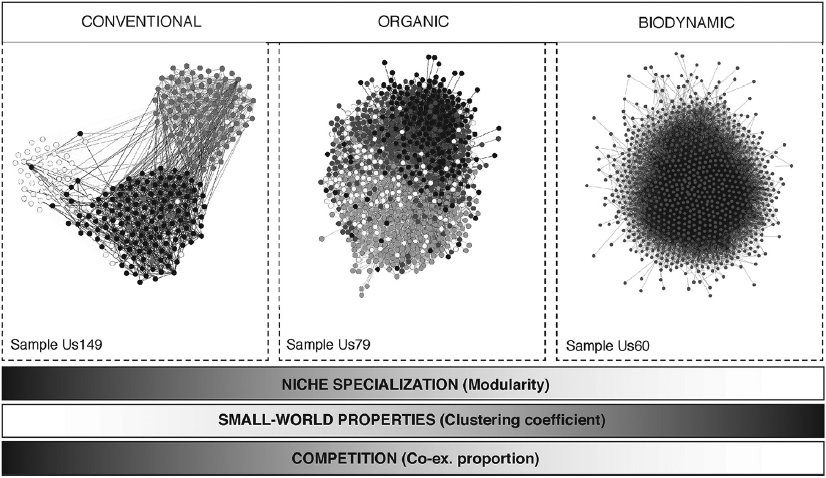Biodynamic agriculture favours adaptive fungal communities
Agroecosystems are managed by humans but remain subject to ecological processes. The type and intensity of management measures have an impact on the ecological composition of the agroecosystem. Fungal communities play a central role in the sustainability of an agroecosystem. In this 2021 study, a team of U.S. and Spanish researchers examined the fungal communities of 350 soil samples from vineyard plots. Organic and biodynamic farming methods which use less intensive management measures resulted in denser fungal communities. These can adapt to changing environmental conditions. In contrast, intensive interventions, which are common in conventional agriculture, led to more specialised fungal networks, which often function according to a mutual exclusion principle and are more sensitive to temperature. The researchers, led by Rüdiger Ortiz-Álvarez, hypothesised that the composition of fungal communities in the soil can provide information on how biotic and abiotic factors influence ecological soil processes. The intensity of soil cultivation can lead to different ecological strategies within fungal communities.
Summary
The living organisms of an ecosystem interact with each other in a complex way and thereby influence the ecosystem in which they occur. This community of organisms is often described in terms of diversity and abundance, i.e. how many different species are present and in what numbers. If we also know which species are mutually exclusive and which only occur together, we can derive a network-based description of a community of living organisms. This includes the interdependencies of individual species and allows conclusions to be drawn about the underlying mechanisms and processes, and about the resulting function of the community within the ecosystem.

Figure 1 (excerpt): Conceptual representation of fungal communities. Combining a basic community description (left) with a description of preferences, interactions, and strategies (metaweb, centre) results in the network-based community description, which allows interpretations of how different communities respond to varying conditions in an ecosystem (right).
In the present study, a network-based approach of this kind was used to investigate the effects of conventional, organic, and biodynamic agricultural practices on the fungal soil communities of viticultural areas. It has been shown that agricultural practices – together with geographical and climatic factors – influence the composition and structure of fungal ecosystems.
Biodynamically managed vineyards showed a tendency to form more grouped and intermixed fungal communities, while the fungal communities in conventionally managed soils tended to be more weakly grouped and the individual species were less coordinated (co-exclusion). In addition, in conventional systems, the selective fertiliser input, which was sometimes high, led to the specialisation of certain fungal species, in contrast to biodynamic systems which favoured generalist and dense communities. It is hypothesised that such generalist fungal communities are more adaptable overall when faced with changes in environmental conditions than are highly specialised communities. Samples of organically managed soils tended to show values in-between those of biodynamic and conventional methods.

Figure 2: The different structures of fungal communities depending on agricultural management. In conventionally managed soils, the fungal community tends toward specialisation, mutual competition, and niche formation, making it more vulnerable to changes such as the elimination of certain species due to human intervention or environmental changes (left). In biodynamically managed soils, the fungal community tends to have a more cooperative, generalist structure that resembles the structure of natural fungal communities in the soil and may exhibit increased stability to external influences (right). The structure of fungal communities in organically managed soils shows characteristics of communities in both conventionally and biodynamically managed soils (middle).
Conclusion
This study did not consider physico-chemical soil properties, which could help to better understand the observed differences in fungal community composition between biodynamic and conventional agriculture. The authors argue that further research should be done. As an example, they cite long-term studies that accompany the conversion from conventional to biodynamic farming. Such studies could help to better understand the human impact on the soil ecosystem, optimise management practices, and simplify the monitoring and promotion of soil health.
The functioning of agroecosystems is not yet fully understood. This is especially true for their resistance and resilience in the face of environmental change. Human intervention in an ecosystem can influence the structure of fungal communities and give rise to two alternative strategies: under biodynamic management, well mixed soil habitats can develop in which fungal communities work more closely together and are more resilient to temperature fluctuations. Under conventional management, more fragmented habitats develop that can cover more specialised niches but have a lower response spectrum to temperature fluctuations. Fungal communities in biodynamically managed soils are similar to the cooperative structures found in unmanaged natural soils. Both the fungal species present, and whether and how closely they cooperate are important factors for soil health.
The researchers hypothesise that cooperatively-based fungal communities, such as those found in biodynamically managed soils, may be more resilient to environmental conditions that are increasingly changing due to climate change and land use.
Details of original study:
Authors: Ortiz-Álvarez, R., Ortega-Arranz, H., Ontiveros, V. J., de Celis, M., Ravarani, C., Acedo, A., Belda, I.
Title: Network Properties of Local Fungal Communities Reveal the Anthropogenic Disturbance Consequences of Farming Practices in Vineyard Soils
Journal: mSystems, Vol. 6, No. 3. 6:e00344-21 (2021)
Link (Open Access): https://doi.org/10.1128/mSystems.00344-21
This study summary was created with the inclusion of the article «Les propriétés des microbiomes révèlent l’influence des pratiques biodynamiques sur les communautés fongiques des sols en viticulture» by Martin Quantin, Biodynamie Recherche.